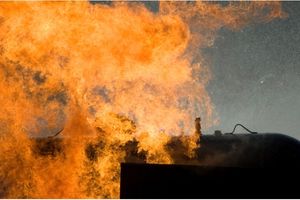Firefighters must be privy to a variety of acronyms, such as BNICE (Biological, Nuclear, Incendiary, Chemical, and Explosive), CFOD, (Commission of Chief Fire Officer Designation), and NTG (nitroglycerin), among many others. Today, we want to talk about one more firefighting acronym, BLEVE. What is BLEVE?

BLEVE is short for Boiling Liquid Expanding Vapor Explosion, an explosion that’s caused when a vessel with pressurized liquid surpasses the boiling point. BLEVE fire situations may crop up occasionally, so a firefighter must be knowledgeable about these dangerous fires.
This guide to BLEVE explosions and fires will explain what causes a BLEVE in great detail. We’ll also talk about how fire departments respond to BLEVE events, so keep reading!
Table of Contents
How Does a BLEVE Occur?
A boiling liquid expanding vapor explosion or BLEVE is just as dangerous as it sounds. During one of these fires, a vessel with pressurized liquid inside like a propane tank exceeds the liquid’s boiling point.
In the case of propane, the boiling point is -43.6 degrees Fahrenheit, but keep in mind that the boiling point for another pressurized liquid can and does vary.
As the boiling point of the liquid increases, so too does the pressure. A canister of propane or another sealed vessel will stay a liquid even in these conditions.
However, once something happens to the vessel, such as someone dropping it, that’s when things change.
Now the structural integrity of the vessel is at risk. The boiling point drops very rapidly, and the pressure decreases just as fast. This causes the liquid inside the tank to become a gas.
The gas will expand at a very fast rate. Combustible gases such as alcohols and hydrocarbons can ignite. Non-combustible gases though may not cause a fire. For example, a steam boiler will produce vapors that don’t catch on fire.
Many more vapors though will cause a fire.

Unlike most fires, heat is not a requirement for a BLEVE. Rather, three criteria must be met. First, the liquid substance must experience a higher-than-usual boiling point.
Second, the pressure can rise, but the vessel must stay intact so the substance can stay a liquid. Then finally, containment loss occurs so the pressure drops quickly.
In some instances, second-stage BLEVEs can follow. The compromised vessel would release vapor to the point where the vapor and the air mix. Ignition then occurs if the vapor is combustible.
Are There Signs a BLEVE Will Happen? What Are They?
As a firefighter, you can’t exactly see into a canister or container to determine whether it may succumb to a BLEVE. That doesn’t mean you can’t rely on other signs to indicate what could be on the horizon.
Here are some symptoms of a BLEVE before a canister ruptures.
Bulges or Bubbles
Look at the tank of propane or liquefied petroleum gas. Does the canister now have a significant bulge or several bubbles when none existed before?
This canister is a good candidate for a BLEVE, and one will likely soon occur.
Metal Pieces Around the Canister
Even an older metal canister shouldn’t flake, but that can change when a BLEVE is about to happen. You may notice tiny metal pieces around the canister that were not there before.
Canister Discoloration
You have a pretty good idea of what color the canister is, correct? If that color begins to change, either lightening or darkening, then prepare for a BLEVE.
Ringing Noise
You’ll need a very quiet environment for this, but if you can hear a consistent ringing sound from a metal canister, then an explosion could be imminent.
Do Firefighters Respond to a BLEVE Fire? How?
Even though a BLEVE is dangerous, it’s still a firefighter’s job to respond to an emergency call that involves a combustible explosion.
That said, firefighter safety is utterly paramount considering the risks of BLEVEs, including the potential for a second-stage BLEVE.
Here are some firefighter safety tips as your department combats a BLEVE.
Watch Out for Flying Debris
Although a BLEVE only occurs when the high pressure in the vessel comes down, the force of an explosion will absolutely lead to flying debris. A firefighter should stay abreast of the risk of flying shrapnel from a variety of directions.
Use Water to Cool the Container
Firefighters will want to put out a burning building caused by a BLEVE, but one or two members of the department should also focus their efforts on flooding the vessel or container in which the BLEVE originated.
The purpose of this is to cool down the container to hopefully avoid a second-stage BLEVE.
Do Not Get Close to the Fire
We saved what is the most important tip for last. Since the radius of an explosion is hard to predict, when extinguishing a BLEVE fire, the firefighters should never get too close to the source of the blaze.
Rely on monitor nozzles as well as unmanned hose holders to keep all the firefighters a good distance away.
A boiling liquid expanding vapor explosion or BLEVE is a high-risk event that occurs when a liquid’s boiling point raises higher than it should, the pressure increases, and then the structural integrity of the container is reduced so the pressure quickly drops.
Do fires always occur after a BLEVE? No, but for each fire that does happen, the risk is substantial. Contact emergency services immediately if a BLEVE has recently ensued and don’t get close to the canister!